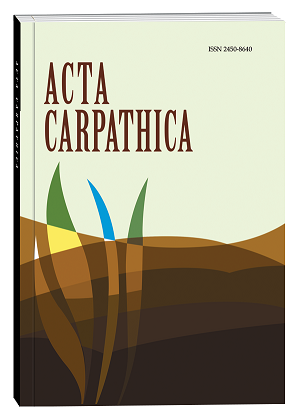ANTIOXIDANT ACTIVITY OF EXTRACTS OF ECHINACEA PURPUREA (L.) MOENCH RHIZOMES WITH THE ROOTS BY DIFFERENT METHODS OF THEIR OBTAINING
DOI:
https://doi.org/10.32782/2450-8640.2024.1.4Keywords:
Echinacea purpurea (L.) Moench, medicinal plant raw material, extract, antioxidant activity, potentiometryAbstract
The article contains the results of the study of the integral antioxidant activity (AOA) of alcohol and water extracts of rhizomes with the roots of Echinacea purpurea (L.) Moench, grown at the educational and research site of Drohobych Ivan Franko State Pedagogical University. The influence of different methods of extraction on AOA indices measured by the potentiometric method using the mediator system was determined. Extraction was carried out by mixing crushed dried medicinal raw materials with 70% alcohol and keeping for 14 days or with distilled water in a ratio of 1:10 at different temperatures and time of its action. In the 1st method of preparing aqueous infusions, water at room temperature was used, in the 2nd – hot water (70 °C), then in both cases the mixtures were heated for 15 minutes in a boiling water bath and cooled for 45 minutes. In the 3rd method, medicinal plant raw materials were poured with boiling water and infused for 15 minutes. To obtain a decoction, medicinal plant raw materials were poured with water at room temperature, infused by heating for 30 minutes in a boiling water bath and cooled for 15 minutes. It was found that the AOA indices of alcoholic extracts of rhizomes with Echinacea roots was 1.2–4.5 times higher than the similar indices in aqueous extracts obtained by different methods and was 1.36±0.09 mg AA/ml. Among the selected methods of aqueous extraction, the most effective was the method of preparation of the decoction, in which the AOA was 1.13±0.08 mg AA/ml. This is explained by the peculiarity of the histological structure and the nature of chemicals synthesized by rhizomes with roots. The lowest AOA values (0.30±0.02 mg AA/ml) were recorded in the aqueous extract obtained by the 3rd method, while the AOA of aqueous extracts by the 1st method was 0.78±0.05 mg AA/ml; by the 2nd method – 0.88±0.06 mg AA/ml, which is 1.5 and 1.3 times lower than the AOA of the decoction, respectively. Therefore, it is advisable to prepare an alcoholic extract of the raw material in order to obtain an extract of the rhizomes with the roots of Echinacea purpurea with the maximum value of AOA.
References
Поспєлов С.В., Шершова С.В. Дослідження біологічної активності лектинвмісних екстрактів ехінацеї пурпурової (Echinacea purpurea (L.) Moench.). Вісник Полтавської державної аграрної академії. 2012. № 1. С. 45–49.
Оптимізація та стандартизація виробництва лікарських засобів на основі ехінацеї пурпурової / О.П. Баула, В.І. Бессарабов, О.О. Нікітіна, І.І. Данюк. Фізико-органічна хімія, фармакологія та фармацевтична технологія біологічно активних речовин : збірник наукових праць / за заг. ред. А.Ф. Попова. Київ : КНУТД, 2018. Т. 1. С. 126–134.
Ефективність використання фітобіотика з ехінацеї блідої у годівлі перепелів: монографія / Р.А. Чудак, Ю.М. Побережець, О.І. Вознюк. Вінниця, 2020. 197 с.
Можливості фармакологічної корекції стрес-зумовлених порушень імунної системи за допомогою лікарських засобів рослинного походження (огляд літератури) / О.Я. Міщенко, О.Л. Халєєва, І.М. Риженко, В.П. Вереітинова. Фітотерапія. Часопис. 2020. № 2. С. 4–10.
Вплив способів екстрагування на антиоксидантну активність екстрактів трави рослин Hyssopus officinalis L. та Melissa officinalis L. Acta Carpathica. О.М. Лупак, Г.Я. Ковальчук, Г.М. Клепач. Acta Carpathica. 2022. № 2 (38). С. 5–13. DOI: https://doi.org/10.32782/2450-8640.2022.2.1.
Gupta A., Naraniwal M., Kothari V. Modern extraction methods for preparation of bioactive plant extracts. International J. of Applied and Natural Sciences. 2012. Vol. 1. Iss. 1. P. 8–26.
Грицик А., Дубель Н., Грицик Л. Дослідження параметрів екстракції трави приворотня. Modern Pharmacy and Medicine. 2021. Vol. 1. Iss. 2. P. 1–9.
Державна Фармакопея України : в 3 т. Державне підприємство «Український науковий фармакопейний центр якості лікарських засобів». 2-е вид. Харків, 2015. Т. 1. 1128 с.
Бандура В.М., Коляновська Л.М. Аналіз сучасних методів та факторів, що впливають на процес екстрагування. Збірник наукових праць Вінницького національного аграрного університету. Серія «Технічні науки». 2014. № 2 (85). С. 130–135.
Antioxidant activity of plants extracts of Ukrainian origin and their effect on the oxidative stability of sunflower oil / A. Demydova, O. Aksanova, V. Yevlash, O. Tkachenko, N. Kameneva. Food Science and Technology. 2022. Vol. 16. Iss. 3. P. 55–64. DOI: https://doi.org/10.15673/fst.v16i3.2314.
Параметри отримання екстрактів Echinacea purpurea та Echinacea pallida для харчових та косметичних продуктів / Н.А. Ткаченко, Н.О. Дец, С.І. Вікуль, Л.О. Ланженко, Д.М. Скрипніченко. Вчені записки Таврійського національного університету імені В.І. Вернадського. Серія «Технічні науки».2018. Т. 29 (68). № 2. С. 251–258.
Лупак О.М., Ковальчук Г.Я., Антоняк Г.Л. Потенціометричне визначення антиоксидантної активності екстрактів рослин Calendula officinalis L. за впливу біостимуляторів росту. Scientific Jornal “ScienceRise: Biological Science”. 2017. № 6 (9). С. 10–13.
Ivanova A.V., Gerasimova E.L., Brainina K.Z. Potentiometric Study of Antioxidant Activity: Development and Prospects. Critical Reviews in Analytical Chemistry. 2015. Vol. 45. Iss. 4. P. 311–322.
Дослідження антиоксидантної активності рослинності Ферганської долини / Д.М. Аронбаєв, В.А. Тен, М.Ф. Юлаев, С.Д. Аронбаєв. Молодий вчений. 2015. № 4 (84). С. 30–34.
Burlou-Nagy C., Bănică F. et al. Echinacea purpurea (L.) Moench: biological and pharmacological properties. A Review. Plants. 2022. № 11(9). Р. 1244. DOI: https://doi.org/10.3390/plants11091244.









